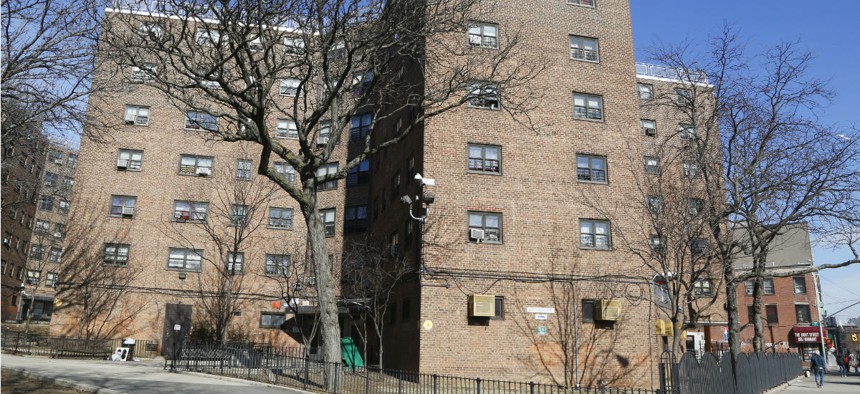One Public Housing Family In New York City Had An Annual Income of Nearly $500,000 in 2013
Watchdog says “over-income” residents in government-subsidized units are squeezing out low-income families.
Thousands of current public housing residents earn more than the income limit for their government-subsidized rentals—squeezing out needier families, according to a new inspector general audit.
The income of as many as 25,226 families living in public housing exceeded 2014 eligibility limits established by the Housing and Urban Development Department, in most cases (13,388 families) by less than $10,000, the watchdog found. Still, the IG found 288 public housing families whose income exceeded the threshold by more than $90,000. Of the 25,226 families, 17,761 had earned more than the qualifying income for more than one year.
New York, Puerto Rico, and Texas had the most “over-income” families in public housing, while Utah, Idaho, and Wyoming had the fewest, the IG found. The term “over-income” applies to those public housing households that earn more than the income threshold established for their locality.
In one case in New York City, a family of four who have been living in public housing since 1988 had an annual household income of $497,911 as of November 2013, the report said. The low-income threshold for that unit was $67,100. The family paid an income-based ceiling rent of $1,574 per month as of July 2014, according to the IG. “In addition, the head of the household owned real estate that produced $790,534 in rental income between 2009 and 2013,” the audit said.
There are more than 300,000 families on the public housing waiting list in New York City, according to the audit which was conducted between 2014 and 2015, at the request of Rep. David (Phil) Roe, R-Tenn.
HUD sets the low-income limits at 80 percent and very low-income limits at 50 percent of the median income for the county or metropolitan area of residence. Each year the department estimates the “fair market rents” for 530 metro areas and 2,045 non-metro county areas.
Approximately 1.1 million families receive public housing assistance in public housing units, so the watchdog’s findings represent 2.6 percent of all public housing households—a fact HUD pointed out, saying the watchdog was “overemphasizing” the problem. But the IG wasn’t buying that argument.
“The public housing program was created to provide affordable housing to eligible low-income families, the elderly, and persons with disabilities,” the report stated. “HUD did not assist as many low-income families in need of housing as it could have.” The watchdog estimated it would pay $104.4 million over the next year for public housing units occupied by “over-income” families that could otherwise be used for low-income people. HUD disputed that figure, saying the IG’s methodology to estimate the subsidy cost of housing over-income families contained a “serious flaw.”
Under HUD regulations, once accepted into public housing, individual households and families can stay as long as they like regardless of increased earnings, provided they comply with rental agreements and remain good tenants. In contrast, HUD’s housing choice voucher program (formerly known as Section 8) has an annual income limit. The housing choice voucher program provides subsidies to families for rental housing in the private sector. Because of the high demand and limited resources, long waiting periods are very common for those trying to obtain both public housing and housing choice vouchers.
The IG criticized HUD for not encouraging public housing authorities (PHAs) to create policies to transition public housing families who become over-income to move to the private, or “unassisted” housing market. A 2004 HUD rule allows PHAs to move families in public housing to the private market if they earn more than the income limit, “allowing authorities to address over-income families within the context of their own unique demographic and economic situations,” the IG said. While HUD oversees PHAs, they are administered by states and localities, and are similar in structure to a school district. Their employees are considered state employees, not employees of the federal government. But PHAs receive a lot of federal money, attracting the attention of Washington.
PHAs told auditors they didn’t evict over-income families because they were not required to do so based solely on income, and that kicking out such households could hamper HUD’s efforts to de-concentrate poverty in government-subsidized housing and create sustainable mixed-income communities.
HUD “repeatedly objected” to the audit, arguing that evicting over-income families “could negatively affect their employment and destabilize properties.” The department also said if all such families were removed from public housing, it would need to request “nearly $116.5 million more in public housing operating subsidies annually,” according to the report. HUD said that the current policies “encourage families to obtain employment and stay employed by not mandating termination of tenancy when a family becomes over-income.”
The watchdog said it didn’t believe that HUD and the PHAs should kick out every over-income family in public housing, but rather they should create “limits to avoid egregious cases.” The IG recommended that HUD reduce the number of over-income families in public housing to free up resources to assist needier families.
(Image via Leonard Zhukovsky/Shutterstock.com)








